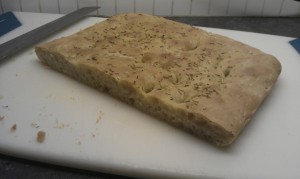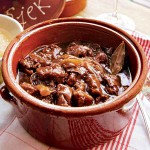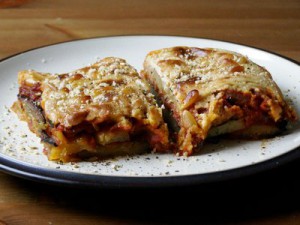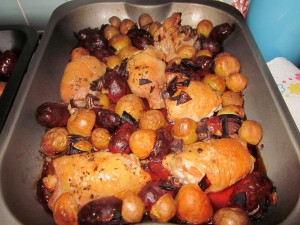I have enjoyed the BBC’s Great Brithsh Bake Off series a lot. My wife has been watching these episodes longer than I have – she is the real cook – but I got increasingly interested because of the sympathetic presentation by Mary Berry and Paul Hollywood. Always amazing what these amateur bakers can come up with…way out of my league.
In the second series, which aired in 2011, Paul Hollywood set a technical challenge to the contesters: to make an Italian Focaccia bread. Ever since I went to Italy with my girl friend (now wife) and ate a real freshly baked focaccia bread, I have been spoiled by that event. I never got an appetite for the factory-baked ones you can buy in the local supermarket. I remember that the original bread tasted great because it was almost soaking with olive oil and was full of mediterranean flavours.
So I promised myself to bake a focaccia one day. However, I was discouraged by the fact that making a good focaccia dough seems to be quite difficult to make. Also, I wanted to use my hands, not a kneading robot to make the dough.
That is why I carefully watched the Brithsh Bake Off Masterclass session where Paul Hollywood showed how he makes his focaccia, and I used the recipe as outlined in his book “How to Bake“. I split the amounts in half because I wanted to end up with a single bread for a 2-3 persons side-dish.
Time required:
2.5 hours for preparation, 30 minutes for baking.
Ingredients:
- 250 grams of strong white flour
- 1 sachet dried fast action yeast
- 1 teaspoon of salt
- 1 tablespoon of olive oil
- 200ml cold water (straight from the tap)
- olive oil, for drizzling
- coarse sea salt
- fresh (preferred) or dried rosemary for sprinkling on top
Preparation:
- Prepare a bowl for proving the dough, by oiling its inside generously. Put aside for later.
- Use a kitchen scale to measure the flour and tip it into into a large mixing bowl. Empty the sachet of dried yeast on one side of the bowl and add the salt on the opposite side of the bowl. They need to be separated because the salt will kill the yeast if the two come into direct contact too soon. Then, add the olive oil, and three quarters of the water. Cold water is better than warm water according to Paul Hollywood. Cold water will activate the yeast more slowly and that will have a positive effect on the flavours that will develop in the bread.
- Stir the ingredients into a dough with a wooden spoon. Instead of using a spoon, you can also use the fingers of one hand to pull the flour into the mix gradually.
- When the water is absorbed you can gradually add the remaining water bit by bit. Knead until all the water has been absorbed before adding more. Focaccia dough is very wet: the ratio flour to water is almost one to one. The more water, the lighter the bread’s inside will be!
- Rub your hands with a bit of olive oil and start kneading the dough in the bowl for around 5 minutes. It will be annoyingly sticky. If needed, you can wash your hands, rub them in olive oil and continue kneading.
- Spread some olive oil on your work surface and dump the dough from the bowl onto the work surface. Continue kneading for another 10 minutes.
- At this point I was getting quite depressed and despairing… because the dough did not turn into a silky non-stick substance (which is what usually happens after kneading a bread dough for a period of time). Focaccia dough will keep sticking to your hands no matter how long you knead it. Just accept that and move on.
- Scrape the dough off the work surface and off your hands, and place it into the oiled bowl you had set aside earlier. Cover the bowl with a tea towel or clingfilm and leave it in a warm place to prove for at least an hour, or until the dough has doubled in size.
- Line a rectangular baking tray (roughly 20 cm by 30 cm in size ) with parchment paper and rub the inside with oil. Gently slide the dough into the tray. Use your fingers to gently stretch and push the dough into the corners of the tray. You do not want to push all the air out!
- Cover the baking tray with clingfilm or a tea towel and leave it to prove for another hour.
- Just before the hour is over, pre-heat your oven to 220 degrees centigrade.
- Remove the towel or cling film. Dip one of your fingers into some flour so that it will not stick, and then firmly push it into the dough, all the way to the bottom of the tray. Repeat this until the focaccia dough has a nice outline of dimples all over its surface.
Baking:
- Sprinkle the focaccia generously with sea salt and rosemary. Sprinkle a few tablespoons of olive oil on top (or hold your thumb to the aperture of the olive oil bottle and drizzle the oil through the narrow gap you leave open).
- Bake the focaccia at 220 degrees centigrade, middle of the oven, for about 20 minutes. It should turn an even brown colour.
- Lift the bread out of the tray using the parchment paper as a handle, and put it on a wire rack. Remove the paper from beneath the bread. Sprinkle with some more olive oil which will get soaked into the bread. Use a high-quality green olive oil if you have that – it will greatly enhance the flavour.
The result is a flat bread with a lovely crispy brown crust, and yet light on the inside. The focaccia has lots of air pockets or various sizes- the sign of a good bake. It tasted great! A real mediterranean treat.
The focaccia should be eaten right out of the oven, or while it is still warm, for the best experience.
Eric.






Recent comments